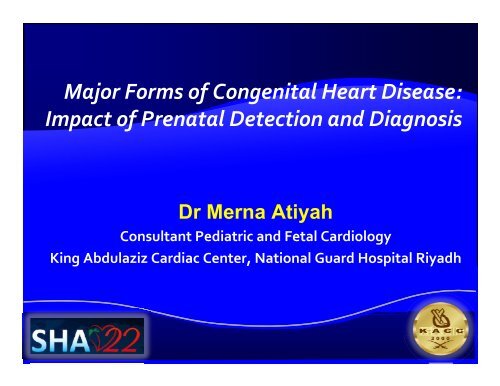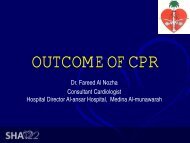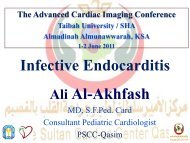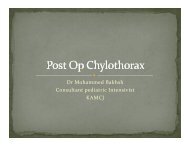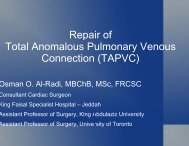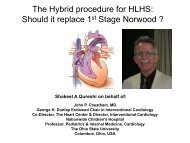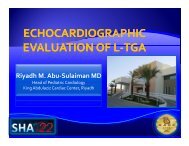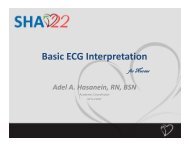Major Forms of Congenital Heart Disease - Sha-conferences.com
Major Forms of Congenital Heart Disease - Sha-conferences.com
Major Forms of Congenital Heart Disease - Sha-conferences.com
You also want an ePaper? Increase the reach of your titles
YUMPU automatically turns print PDFs into web optimized ePapers that Google loves.
<strong>Major</strong> <strong>Forms</strong> <strong>of</strong> <strong>Congenital</strong> <strong>Heart</strong> <strong>Disease</strong>:<br />
Impact <strong>of</strong> Prenatal Detection and Diagnosis<br />
Dr Merna Atiyah<br />
Consultant Pediatric and Fetal Cardiology<br />
King g Abdulaziz Cardiac Center, , National Guard Hospital p Riyadh y
Impact <strong>of</strong> Prenatal Diagnosis for Management<br />
Strategies<br />
Simpson JM. 2006<br />
Krapp M, <strong>Heart</strong> 2003
Impact pact o<strong>of</strong> Prenatal e ata Diagnosis ag os s for o<br />
Management Strategies<br />
� Intrauterine evolution <strong>of</strong> CHD<br />
One <strong>of</strong> the major advances <strong>of</strong> fetal<br />
echocardiography: understanding the<br />
morphology and the pathophysiology <strong>of</strong> CHD<br />
before birth. EEnrico i Chi Chiappa, JJournal l <strong>of</strong> f CCardiovascular di l MMedicine di i<br />
2007
Hornberger LK, Left heart obstructive<br />
lesions and left ventricular growth in the<br />
midtrimester fetus. Circulation 1995
Impact <strong>of</strong> Prenatal Diagnosis for<br />
Management Strategies<br />
Intrauterine Transcatheter Valvuloplasty<br />
Courtesy <strong>of</strong> DR ZIELINSKY
Impact <strong>of</strong> Prenatal Diagnosis for<br />
Management SStrategies<br />
Improvement in detection <strong>of</strong> CHD.<br />
Understanding the morphology and the pathophysiology <strong>of</strong> CHD<br />
Accurate Diagnosis <strong>of</strong> CHD<br />
Early Family Counseling<br />
Prenatal treatments<br />
Planed delivery (In utero transportation and <strong>com</strong>petition among centers)<br />
Immediate appropriate pp p postnatal p<br />
treatments
Impact <strong>of</strong> Prenatal Diagnosis for<br />
Management Strategies<br />
90<br />
80<br />
Optimal 70<br />
60<br />
50<br />
Medical<br />
Care<br />
40<br />
30<br />
20<br />
10<br />
0<br />
Fetal Dx Postnatal DX
Prenatal Diagnosis <strong>of</strong> CHD<br />
Does it make a difference to survival??
Impact <strong>of</strong> Fetal Diagnosis on Survival<br />
No difference in Survival or even a worse<br />
mortality observed in <strong>com</strong>parison with<br />
cases with only postnatal diagnosis<br />
� I D Sullivan, <strong>Heart</strong> 2002<br />
� Enrico Chiappa, Journal <strong>of</strong> Cardiovascular Medicine 2007<br />
� Kumar RK, Hornberg LK, Am J Cardiol 1999<br />
� Daubeney PE, Circulation 1998
Survival advantage reported in the literature in<br />
selected types <strong>of</strong> CHD<br />
� BBetter tt preoperative ti clinical li i l status t t<br />
� Better survival in some <strong>of</strong> the duct<br />
dependent cardiac lesion<br />
(d-TGA, ( , COA) )
Mortality benefit
Lower incidence <strong>of</strong><br />
preoperative acidosis<br />
Less need for preoperative<br />
inotropic p<br />
medications
Coarctation <strong>of</strong> the aorta<br />
� Common duct dependent cardiac defect<br />
missed at routine physical screening <strong>of</strong> the<br />
neonate.<br />
� An estimated 60% <strong>of</strong> newborns with isolated<br />
coarctation are sent home as “healthy” babies<br />
� Hikoro Matsui et al, Circulation. 2008
Prenatal diagnosis <strong>of</strong> TA did not appear to<br />
have a significant impact on short-term survival<br />
83% vs 81%<br />
Sittiwangkul R, Van Arsdell GS. Ann<br />
Thorac Surg 2004
Conclusions—Prenatal diagnosis did not affect overall<br />
survival despite facilitated care. The prognosis <strong>of</strong> RAI was<br />
worse <strong>com</strong>pared with LAI because <strong>of</strong> more <strong>com</strong>plex<br />
associated cardiac defects and the inability to perform<br />
successful surgical procedures.
�� Spectrum <strong>of</strong> CHD in fetal is different<br />
from that in postnatal<br />
Lesions detected antenatally most <strong>com</strong>monly<br />
underwent termination <strong>of</strong> pregnancy or had a<br />
relatively poor prenatal (Ebstein’s anomaly) and<br />
postnatal (SV) out<strong>com</strong>e.
Spectrum <strong>of</strong> CHD in fetal is different from<br />
that in postnatal<br />
11- Prenatal detection rates for many major cardiac<br />
abnormalities.<br />
22- MMethod th d <strong>of</strong> f selecting l ti cases for f fetal f t l<br />
echocardiography<br />
3-The tendency to a lower gestational age at birth in<br />
prenatal diagnosis series<br />
4-Antenatal assessments <strong>of</strong> the fetal hearts with 4<br />
chamber view<br />
Copel JA, Tan ASUltrasound Obstet Gynecol 1997
Anomalies detectable by<br />
abnormal ventricular<br />
outflow 6.7%<br />
Anomalies detectable by<br />
four-chamber view 30%
� 25% in living infants diagnosed to have CHD<br />
after discharge home
37%<br />
40%<br />
44<br />
54%
� Continuous Training program for obstetric<br />
sonographers<br />
�� Constant feedback
FETAL CARDIAC PROGRAM<br />
KING ABDULAZIZ CARDIAC CENTER<br />
IMPROVEMENTS IN THE ANTENATAL<br />
DETECTION DETECTION AND AND DIAGNOSIS DIAGNOSIS OF OF CHD CHD
� About 40% <strong>of</strong> congenital heart defects can be<br />
discovered with just the four four‐chamber chamber view in a<br />
low risk population, and additional examination<br />
<strong>of</strong> the outfl ow tracts and the two great arteries<br />
increases this rate to 70% 80%and en<strong>com</strong>passes<br />
all critical cardiac defects.[17‐20,33,34,36,37<br />
[7 ,33,34,3 ,37<br />
� Gardiner HM. Fetal echocardiography: 20 years<br />
<strong>of</strong> progress. <strong>Heart</strong> 2001
� the detection rate is 85%‐95% at tertiary<br />
perinatal centers<br />
� RRaupach h K K, FFalse l di diagnosis i i in prenatal l<br />
sonography Ultraschall Med 2004<br />
� Huhta h J, Curr Opin Pediatr d 2004
� Possible risk factors in 10%‐30% <strong>of</strong> fetuses with<br />
cardiac lesions<br />
� SSonographic hi " "abnormalities" b lii " on obstetric b i<br />
ultrasound screening during prenatal care<br />
depend on the expertise available in pre pre‐ and<br />
perinatal centers<br />
�� Friedman AH,where we've we ve been, where e are. Prenat Diagn 2002.<br />
� Hornberger LK, In utero pulmonary artery and aortic growth and potential for<br />
outfl w obstruction in TOF ,Am Coll Cardiol 1995


